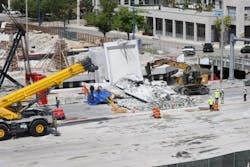NTSB determines likely cause of FIU pedestrian bridge collapse
The National Transportation Safety Board (NTSB) determined during a public board meeting held this week that the probable cause of the Florida International University (FIU) pedestrian bridge collapse in March 2018 was due to load and capacity calculation errors made by designer FIGG Bridge Engineers Inc.
The agency said that consultant Louis Berger's inadequate peer review also contributed to the collapse, as it failed to detect FIGG's calculation errors in its design of a main span truss member nodal region and connection to the bridge deck. NTSB also said the FIGG engineer of record’s failure to identify the significance of structural cracking observed in this node before the collapse, and failure to obtain an independent peer review of the remedial plan to address the cracking, further contributed to the collapse.
The FIU bridge collapse killed six people and injured 10 others on March 15, 2018 near the city of Sweetwater, Florida. Upon its collapse, the 174-ft-long, 950-ton span fell onto traffic on SW 8th Street, crushing eight vehicles under the structure. Six out of the eight lanes of roadway were open to traffic at the time.
During this week's board meeting, NTSB said the failure of FIGG, MCM, Bolton Perez and Associates Consulting Engineers, FIU, and the Florida DOT (FDOT) to halt bridge work and close SW 8th Street to protect public safety contributed to the severity of the collapse outcome.
“Errors in bridge design, inadequate peer review, and poor engineering judgment led to the collapse of this bridge,” NTSB Chairman Robert Sumwalt said in a statement. “The failure of all concerned parties, to recognize and take action on the threat to public safety presented by the significant observed bridge structure distress prior to the collapse, led to the tragic loss of life in this preventable accident.”
Over the summer, the Occupational Safety and Health Administration released its own investigative findings of the collapse, the conclusions of which largely placed blame with FIGG as designer of the bridge as well. Earlier this month, NTSB released 6,300 pages of documents connected to its investigation of the collapse.
Among the 30 key findings in its investigation, NTSB found that the rate of premature concrete distress was clear evidence the structure was progressing toward failure and should have alerted FIGG and MCM to the origin of the distress.
Based on its investigation of the bridge collapse, NTSB issued 11 safety recommendations in total, with one issued to the Federal Highway Administration, five issued to FDOT, three issued to the American Association of State Highway and Transportation Officials, and two issued to FIGG Bridge Engineers Inc.
------
SOURCE: NTSB
